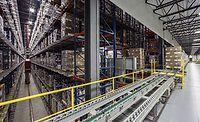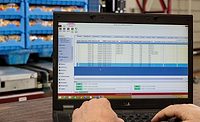Time is a valuable commodity for busy beverage warehouses with an ever-increasing number of SKUs. These warehouse operators cannot afford to waste precious time locating and tracking inventory — especially because 64 percent of U.S. warehouses are more than 25,000 square feet, according to Dallas-based Cisco Eagle.
With more than 3 billion square feet of warehousing space added between 2000 and 2012, beverage distributors are pressed to be more efficient with placement, power, access, layout and other factors, including technology, Cisco Eagle notes.
Warehouse management systems (WMS), working in tandem with warehouse control software (WCS), can help beverage wholesalers operate more efficiently — often at the touch of a button — by controlling and managing inventory, raising productivity, boosting throughput, enhancing customer satisfaction, cutting costs and more, the company adds.
“Management systems enable us to manage the inbound product, view it and fill orders — bulk, mixed pallet bulk and small-format mixed pallet loads — and understand what needs replacing,” says John Barry, vice president of sales and marketing for Illinois Tool Works (ITW) Warehouse Automation, Arden, N.C.
“The other key is how to store the inventory, where to place it in the warehouse, racking, static storage, cold rooms, in automated storage area,” he continues. “This coordination or documentation is key for when you want to pick the product to fill the orders. It helps with the efficiency of the picking process and improving traceability.”
A warehouse’s ability to control inventory and order building determines whether wholesalers need a WCS or a WMS, Barry notes.
“These systems can be used independently or integrated together, but if there are no controls in place to view process, a WMS will help greatly,” Barry says. “The larger or more complex the operation (SKUs, type of packaging, etc.), the greater advantage a WMS offers.”
Functional control
In order to ensure WMS and WCS operations are running effectively, suppliers offer software programs that can support operations throughout the warehouse. York, Pa.-based Westfalia Technologies Inc.’s Savanna.Net software features WMS and WCS functionalities. “It has the flexibility to operate as a standalone software solution that simplifies and controls the entire warehousing process while reducing the complexity of using several different ‘function-specific’ applications,” the company’s Software Development Director Dave Williams notes.
“Savanna.Net gives users the functionality necessary to efficiently receive, store and track product, as well as optimally marry inventory to customer orders using the solution’s integrated order fulfillment processing capabilities,” he continues. “When an order is to be fulfilled, Savanna.Net processes that order into units of work. …either automated material handling equipment or manual labor to execute the work.”
Prior to implementing WMS or WCS operations, ITW’s Barry says beverage manufacturers and wholesalers should clearly define and assess their goals, find a vendor that meets their needs, hire the right staff that can operate and understand the system, and locate a vendor that provides strong customer support for day-to-day operations as well as future development needs.
Westfalia’s Williams notes that technology acquisitions are major capital investments that deserve “careful due diligence.” Most firms want to see a return on investment (ROI) within one to five years, but “labor savings and economies achieved through inventory reduction along with the accuracy of the information a WMS provides should not be overlooked,” he says. “ROI is not strictly about headcount reduction and dollars and cents.”
Prior to WMS/WCS implementation, Williams advises management teams to consider the following factors: software sustainability and features, customer support, cost, consistency, and long-term support.
“If a business is just looking at a warehouse management system with no plans to automate, then integration (between WMS/WCS) is not critical,” Williams says. “However, if product movement with automation (LGVs, conveyors, etc.), stretch-wrapping, automated label application is under consideration, then the ability to integrate the WMS and WCS is vital.”
Automated applications
“Automation just makes for another ‘black box’ to deliver products to,” ITW’s Barry says. “The key is that the WMS software has the ability to communicate with the automation software.”
Barry adds that ITW offers a complete WMS operation that can control all operations within the four walls of a warehouse. Its products can dictate movement, understand inventory and coordinate all outbound orders.
“With additional automation, warehouse management systems will control more actions and store more information than ever before. The need to become more customized will also grow,” Barry says.




